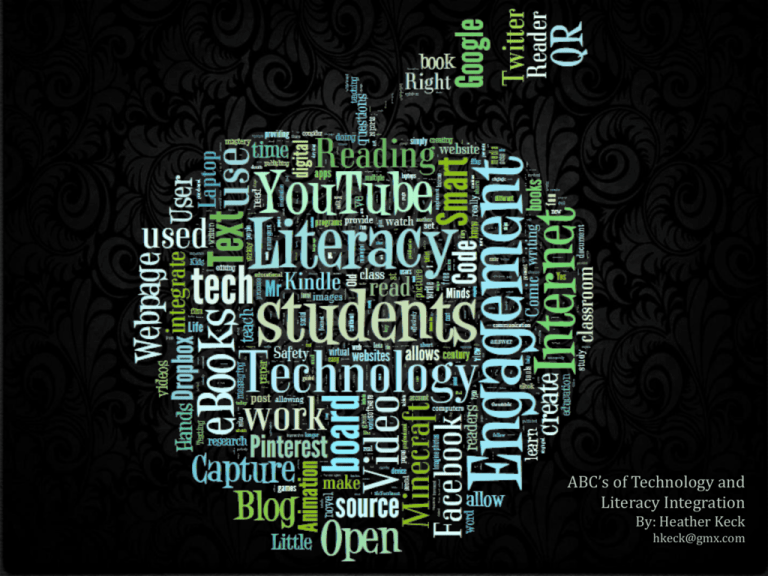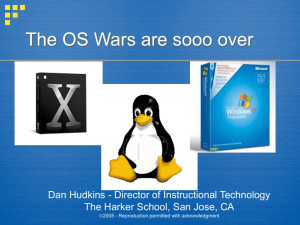File - Heather Keck
advertisement

ABC’s of Technology and Literacy Integration By: Heather Keck hkeck@gmx.com st 21 Century Literacy Literacy has evolved, becoming now a mastery of communication, rather than simply a mastery of text. Students in the 21st Century still need to know how to read and write, but they also need to know how to speak and listen effectively. Their audience is no longer the person sitting behind the teacher’s desk – it is global. The tools to get there are no longer limited to pencils and paper. Technology provides the key to increased student engagement, motivation, and education by providing students with meaningful uses of tech to teach them to become literate. These are just a few ways to shape 21st century students into 21st century masters of literacy. Stop Animation is comprised of a series of images taken in which only a tiny potion of the picture changes. The images are then played in sequence to give the illusion of a film. A blog is like a digital diary that everyone can see and comment on. There are some well written, professional blogs out there, as well as a growing variety of student work. Comic Life is a program that allows students to create comic strips by providing an easy drag and drop interface that they can use with their own images and photos. Dropbox is like a virtual briefcase. You can store your files on it and access them anywhere. This program allows for multiple connections from one user name, so it’s really easy to have a class account. eBooks are books in a digital format. They can be read on computers, tablets, or eReaders. Typically their pages scale automatically to fit the device they’re being read on. You can also include sound, video, and clickable web links in an eBook, where you can’t in a printed one. Facebook is the largest social media site. Rather than shy away from the media our students use, we should embrace it. If you make the tools meaningful to the students, you’ll find their motivation to succeed goes up. Google Docs is a free service provided by Google. It allows multiple users to work on a single document at the same time from anywhere without anyone overwriting anyone else. Hands on, minds on is a catchphrase that perfectly describes the increase in engagement when the students are given something ‘fun’ to work with. The internet is a series of computers all connected together. You access it by ‘connecting’ your device to it. The benefit of the internet is that it allows you a way to instantly communicate through email, or messaging. It allows you instant access to photos, files, articles, music, and video. It allows you to create your own space (webpage) that anyone can see where you can publish your work. Just Right Tech refers to using the right tech for the right job at the right level. Just because that iPad app is designed for kindergarteners it doesn’t mean that they will find it easy to use or engaging. Just because you put an iPhone in the hands of a student and ask them to take photos, while they may be engaged, they may not be doing what you want them to. A Kindle Fire is a type of eReader. This specific model is able to access the internet, and has speakers so it can play audio books, or books that will read to emergent readers. Most eBooks purchased can be installed/used on six devices from one license. Many libraries today also allow you to ‘rent’ digital editions, and there are several websites that provide free eBooks. That really lowers the cost of class sets! A laptop is a portable computer, and is different from a tablet because it has a keyboard where a tablet has a touch screen. Laptops should be used the same way you would use a computer, where as a tablet should be used as a paper-free machine to create only digital media. Minecraft is a sandbox game where the users create the content and set the rules. Anything goes in Minecraft, and if you can imagine it, then you can do it. It can be used to engage and educate in many ways. MrNussbaum.com is a website with thousands of educational games. This is a great way to engage students in learning about language arts in a fun way. Open Source Software is free software that’s being developed by anyone. Wikipedia is a great example of an open source concept. You can get word processors, image editors, webpage design programs, and many, many more types of software of professional caliber with full support at no cost. Pinterest is a digital cork board or a visual bookmarking tool for websites. After you have an account, you can browns the web and ‘pin’ interesting things to your board. You can have more than one board at a time, and can pin from multiple computers/devices at once. A QR Code is like a digital fingerprint. If you scan it with a QR reader, usually on a smartphone, and it will take you to a website, or generate text based on the ‘picture’. Little Reader is a line of iDevice apps that focus on teaching emerging readers to read by pairing words with images and sounds. It’s sort of like a digital flashcard program that’s fun. A Smart Board is a brand of interactive whiteboards. It’s like a normal whiteboard except it’s hooked up to a computer so you can show anything on it like you would through a projector. You can save what you write on the whiteboard to a file for later use. It also is touch sensitive, so you can run educational apps directly on the board like an oversized iPad. Twitter is another very popular form of social media familiar to many students. It’s a micro-blogging site that allows users to make short posts that others can follow. User safety is important to consider. While students may have access to tech at home, their parents/guardians may not know how to use it effectively. Lessons on ‘Netiquitte’ , ‘Cyber Bullying’, and ‘User safety’ should be considered when planning your lessons. Just like you teach students not to run with scissors, they need to be taught not to make themselves targets. Video Capture is a fancy term for recording something to video. By making a video of students’ work, they are more motivated and engaged by raising the level of concern. You can even post the videos on a class or student website so friends and family can share in the student’s learning. In the digital world, websites are user created pages published for the world to see. They can contain stories, facts, pictures, art, opinions, sound clips, videos .. Anything! They are a permanent public portfolio highlighting their author’s opinions and education. Texting, short for text messaging, is a way of communicating through quick, written short messages usually sent on a cellphone or through a text messaging program on the computer such as MSN. Texting will make you stupid. I know I’ve heard that one before. However, what most people fail to notice is that every time someone sends a text, they have to write it first, and someone else reads it. This makes students today prolific readers and writers, creators and communicators. Why not harness this passion and use it to differentially teach kids, participate in a silent group-discussion, or poll students? YouTube is a video hosting site. There are thousands of videos posted in a user moderated forum. With YouTube students could view books being read to them, share their own reader’s theatre presentations, watch plays being preformed, and learn how to do things visually. Make sure you preview the videos you plan to show, and turn off ads. Reading A-Z is an online leveled reading program with a strong emphasis on emergent literacy. This program has 875+ stories and Raz-Kids integration, allowing for differentiated learning for all students. Index A – Animation B - Blog C – Comic Life D – Desktop, Document E – eBooks F – Facebook G - Google Docs H – Hands on, Minds on I – Internet J – Just Right Tech K – Kindle Fire L – Laptop M – Minecraft N - Mr. Nussbaum O – Open source P – Pinterest Q – QR Code R – Little Reader S – Smart board T – Twitter U – User Safety V – Video Capture and edit W – Webpages X – Text Y – YouTube Z – Reading A to Z
